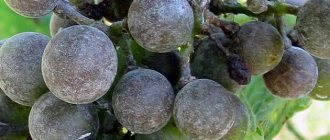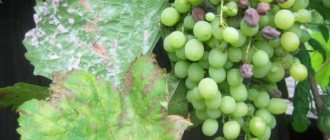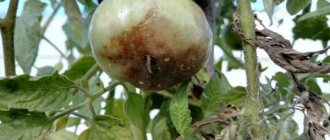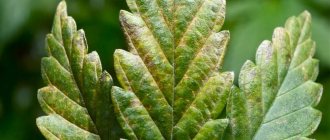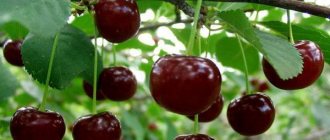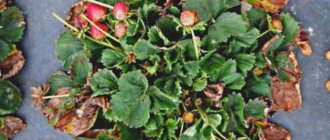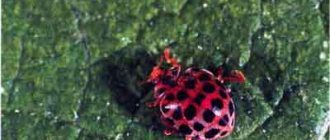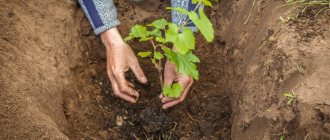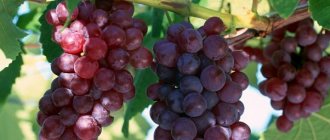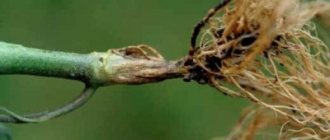What is mildew on grapes, grape leaves: what does it look like, the pathogen, signs of the disease?
Mildew is called downy mildew, it occurs as a result of the action of fungal spores on green leaves. The most interesting thing is that the disease came to our country after 1887. It was then that the Americans first brought the fungus to Europe. Since then it has spread to all regions of Europe and Asia. It is this disease that causes the death of a large number of grape bushes.
The disease does not appear immediately; it is quite difficult to notice, because at +8, fungal spores begin to grow along with raindrops and fall on green leaves and infect them.
Signs:
- Initially, you can notice light spots on the leaf, which then turn yellow.
- Something similar to an oil stain also appears.
- Throughout the entire grape growing season, several outbreaks of the disease are observed.
- It becomes almost invisible during the period when round, green berries appear.
- But as they ripen, the skin dries out and becomes covered with a very dense crust. Such berries are not suitable for food.
Signs of mildew
Initial stage of mildew development
How dangerous is infection?
Mildew spreads very quickly (up to 16 generations of the fungus are formed in 1 season), and it is quite difficult to fight it. However, the danger of rotting bushes is not all that the disease can cause for a vineyard.
- Affected plants attract pests and parasites.
- The harvest this year and next year is reduced by up to 50%.
- The quality of fresh berries and processed products is deteriorating.
- The bushes become unsuitable for taking cuttings.
- Plants weaken and do not tolerate winter well.
Reference! Even if the disease has not become widespread, the harvest will still suffer - the berries will lose their taste.
What is oidium on grapes, grape leaves: what does it look like, the pathogen, signs of the disease?
Oidium is a disease that, along with mildew, causes the greatest damage to grape plantations and causes the decline of grape production. The fact is that the disease is caused by the powdery mildew fungus. Infection occurs quite quickly, and most often appears if the bushes are in a poorly ventilated place and there is a lot of moisture in the soil.
Signs:
- It looks as if the vine was sprinkled with flour or some kind of ash.
- The inflorescences are also covered with some kind of dust, and over time they become brown in color.
- The disease also causes a lot of harm to the berries themselves, because when the fungus spreads, the berries burst, the seeds turn out, and a large number of berries do not ripen.
- Growth stops at the stage when the size of the berry is not very large.
Oidium Oidium
Oidium under a microscope
What is Mildew?
Mildew is a common and harmful disease.
The rate of mildew disease directly depends on air temperature.
Mildew progresses in conditions of high humidity.
Oidium has another name: powdery mildew.
Diseases can affect not only leaves, but also berries.
The oidium mycelium easily survives the winter.
Mildew is a fungal infection, the main cause of which is infection with the fungus Plasmopara Viticola.
This species came to Europe from North America in 1878 . And through the vineyards of France it gradually spread throughout the entire area of European space. As a result, at the end of the 19th century, this led to a significant decline in grape production and winemaking.
Peculiarities
Mildew disease can affect up to 80% of berries.
Mildew is one of the most dangerous and at the same time common diseases.
Its second name is downy mildew . Just a few days after the fungus spreads, there is a risk of losing almost the entire harvest and reducing the productivity of the vineyard to zero.
Causes
Treatment is carried out with antifungal drugs.
There are a number of favorable factors contributing to the development of infection. These include:
- high humidity;
- heat;
- oversaturation of soil with nitrogen fertilizers;
- early pruning of grapes;
- individual susceptibility of the variety;
- violation of deadlines for gartering shoots.
Most often, the bush is affected during the flowering period or at the time of berry formation.
Consequences
The disease begins with damage to grape leaves.
The consequences of mildew infection are also significant. In addition to the risks of crop loss, there may be:
- the sugar content in fruits is significantly reduced;
- ripening of shoots is observed;
- the winter hardiness of the variety decreases.
Signs
Good ventilation of the bushes will eliminate the appearance of the disease.
The disease can be identified by the following signs:
- Yellowish oily spots form in the upper part of the leaf blade.
- After exposure to moisture (fog, rain, dew), a coating appears on the bottom of the leaf, which dries over time and acquires a brown tint.
- The shell of the fruit dries. Individual berries take on pear-shaped shapes.
- Brown spots are visible on the shoots, which turn black over time.
Protecting grapes from diseases: preparations, comprehensive measures
In order to combat various grape diseases, it is necessary to adhere to comprehensive measures and prevention. They prevent the development and reproduction of pathogens.
Processing stages:
- Peace. In general, we can say that this stage lasts almost the entire winter and spring, until the temperature rises above plus 10 degrees. The vines are treated twice with copper sulfate. For this, a three percent solution is prepared. The first treatment is carried out before sheltering for the winter, and the second after you remove the shelter in the spring.
- Kidney development. At this time, it is necessary to carry out treatment using Bi-58 or Collis . They are effective against mites and oidium. When the buds have bloomed, it is necessary to treat against spotting, insects, and parasites that overwinter in the ground.
- The appearance of leaves . When you see that three to five leaves have appeared, for the purpose of prevention, treatment is carried out against mildew and gray rot. Fungicides such as Horus, Delan, Dimilin .
- Bloom . Treatment is carried out twice before the first flowers appear and 5 days after the grapes have faded. At this time, treatment is carried out against mildew, gray rot, and mites. The drugs used are Octopas, Ridomil Gold, Strobi or Quadris . During this period, treatment with mineral fertilizers is also encouraged.
- Berry development . When you see that the berries have become the size of a pea, it is necessary to treat them with Ditan M45 . No preparations or fungicides are used against mildew and oidium, when fruit coloring is observed, so that the berries are not toxic. During ripening, only drugs such as Fitosporin and Baikal . They are non-toxic and are bacteria.
- Picking berries . After you have harvested, you need to prepare the vine for wintering. For this purpose, fungicide treatment is carried out. The ideal option would be iron sulfate or fungicides such as Bi-58, Collie s.
Grape processing
Grape mildew: treatment, prevention
Since mildew develops cyclically, it is necessary to carry out treatments in exactly the same way. But if you do not want to detect outbreaks of the disease, constantly sit near the vineyard, looking at the leaves, then we recommend that you carry out treatments every 10 days. In addition, there are preventive measures that prevent the proliferation of fungal spores.
Prevention:
- It is necessary to mulch the soil
- Dry the grapevine after rain
- Carry out drip or drainage irrigation
- You can’t flood the plant or water the leaves.
Among the preparations, Bordeaux mixture can be distinguished. Treatment is carried out every 10 days. It is necessary to dissolve 100 grams of copper sulfate and quicklime in a 10 liter bucket of water. Treat the leaves with the resulting liquid.
A large number of drugs called fungicides are also used. They fight not only mildew, but also other fungal diseases of grapes.
List of drugs:
- Delan
- Horus
- Profit
- Thanos
Profit fungicide
Causes and provoking factors of infection
Small fungal spores easily fall on the vine with gusts of wind, on the legs of insects and on the gardener’s clothing. Once on the plant, the pathogen invades living tissue and begins to develop intensively. Favorable conditions for spore reproduction:
Air temperature from + 25 degrees
Density of branches and close proximity of bushes
Presence of weeds on the soil under the bushes
Oidium on grapes: treatment, prevention
In order to avoid the appearance of oidium on grapes, it is necessary to carry out preventive measures in time. Since this fungal disease develops in conditions of high humidity and in secluded corners of the planting. Regular ventilation and thinning of grape bushes is necessary. Exceeding the watering norm is also not allowed.
It is worth paying attention to the fact that oidium is very sensitive to sulfur. Therefore, if you find white spots on the leaves, you can treat with colloidal or crystalline sulfur. Spray the entire leaves, vine, and soil layer. Because fungal spores can be on the soil surface. There are also drugs against oidium.
List:
- Fundazol
- Topaz
- Spark Bio
Spark bio
Spider mites on grapes: treatment, prevention
The fact is that mites on grapes quickly get used to various types of chemicals, so you cannot treat them several times in a row with the same preparation. It is recommended to change them. An excellent option for tick control is colloidal sulfur. But the effect is observed only at temperatures above 15 degrees. In the cold season, that is, in March, it is useless to treat with sulfur. Because it won't be very effective. In such conditions, complex preparations, as well as pest control products, work well.
List:
- Karbofos
- Talstar
- Nitrophen
- Omite
- Fufanon
Fufanon
Medicines against mildew and oidium
There are a huge number of antifungal fungicides. To combat oidium, use:
- "Topaz";
- "Tiovit Jet";
- "Horus";
- "Cumulus DF";
- "Strobe."
Experienced winegrowers treat plantings with colloidal sulfur. If the infection is weak, it is allowed to use a five percent solution of baking soda and slightly diluted potassium permanganate (5 g per 20 liters of warm water).
Mildew is treated with the use of products that contain copper. This group includes:
- Bordeaux mixture;
- "Quadris";
- copper sulfate;
- "Abiga-pik";
- "Polychomus";
- "Oxychom";
- "Cuprozan".
The use of copper-containing products is contraindicated for some varieties. They are processed with “Tiram”, “Mancozeb”, “Kaptan”, “Zineb”.
Treatment and prevention of grape diseases with copper sulfate: instructions
Copper sulfate is effective against fungal diseases of grapes, such as mildew and oidium. With the help of this substance, both preventive and therapeutic treatments can be carried out. Therapeutic treatment is carried out three times per season. The first time with the appearance of the first buds, the second time before flowering, the third time after it.
Instructions:
- Dissolve 300 g of copper sulfate in 10 liters of hot water
- Stir until the salt dissolves
- Spray three times per season as above.
- It is necessary to wet the leaves, vines and topsoil
Copper sulfate treatment
Disease prevention
Previously, oidium affected mainly grapes growing in the southern regions, but today the geography of incidence has spread to other areas. This is due to general climate warming. To prevent the fungus from affecting the plantings, it is necessary to take a number of preventive measures:
- treat grape bushes with three percent Bordeaux mixture;
- collect and burn fallen leaves;
- before the buds open in the spring, spray the bushes again with Bordeaux mixture;
- Disinfect garden tools with copper sulfate to which lime is added;
- with the appearance of the first leaves, treat the bushes with sulfur powder, without missing a single one, spraying the preparation on the inside and outside of the plate;
- Constantly thin out the bushes so that the planting is saturated with oxygen.
Experienced winegrowers strongly recommend not to neglect autumn pruning, which allows you to accumulate the strength of the plant and strengthen the immune system.
Rate this post
Treatment and prevention of grape diseases with phytosporin: instructions
Fitosporin is a fungicide, but it is not exactly a chemical preparation. It is based on Bacillus subtilis, that is, living bacteria that are found in the soil. They effectively combat a diverse pathogenic environment, prevent the development of fungi, viruses, and various grape diseases. Treatment is carried out three times per season: in early spring, before flowering, and after it. It is worth noting that phytosporin is not very effective if the disease is in an advanced stage. In this case, you need to use chemicals and active fungicides.
Instructions:
- In order to carry out the treatment, you need 5 g of powder in a 10 liter bucket of water.
- Treat leaves, vines, and surface layers of soil. Treatment is carried out in the same way before flowering.
- After flowering, we recommend increasing the dose of the substance by 2 times and making it more concentrated. That is, dissolve 10 g of the substance in 10 liters of water and carry out the treatment.
Fitosporin is not harmful to humans and bees, so it is absolutely safe to eat grapes, even without a certain aging or any ripening standards. In fact, if the plant is sick, treatment with phytosporin can be carried out even when there are ripening berries on the clusters.
Fitosporin
Treatment and prevention of grape diseases with Bordeaux mixture: instructions
The treatment is carried out with a strong solution. To prepare it, you need to make a special liquid.
Instructions:
- In a metal enameled bucket, pour 300 g of quicklime with two liters of hot water. Stand back and stir with a wooden stick because a violent reaction will occur.
- Be careful not to get the solution on your skin or eyes. In another container, you need to dilute 300 g of copper sulfate with 8 liters of water, and also mix.
- After the lime stops bubbling, you need to mix the two solutions. It is this liquid that is used to treat the leaves, vines, and the top of the soil.
- Three applications per season are sufficient if the weather is dry. If there is a rainy season, then treatment with this mixture should be carried out once every 10 days. Because at this time there is an increased risk of fungal diseases.
Bordeaux mixture
Traditional methods
You can effectively fight mildew using various folk methods that have proven themselves well. Treatment with folk remedies involves the use of chemical solutions, as well as special infusions and decoctions. The most popular remedy is copper sulfate and preparations based on copper oxides. The concentration of copper sulfate for spraying disease-affected plants can range from one to three percent.
Bordeaux liquid
You can cure a vineyard that is “sick” by spraying the bushes with Bordeaux mixture. Let's look at how to prepare it correctly. First you need to select a container for the solution. Do not make the preparation in metal or galvanized buckets. It is better to take dishes made of glass, wood or ceramics.
To prepare ten liters of a one percent solution of the drug for the treatment of mildew, you need to take one hundred grams of slaked lime and the same amount of copper sulfate. Dilute copper sulfate in one liter of hot and five liters of cold water. In another container you need to prepare slaked lime. To do this, one hundred grams of lime is poured with five liters of water and then filtered. At the final stage of preparing the drug for treating mildew, mix the two solutions by slowly pouring copper sulfate into slaked lime.
It is worth noting that for the first spraying it is better to take a less concentrated composition of Bordeaux mixture. During subsequent treatments, the percentage of concentration of the product is increased, and in case of severe infection of grape bushes with mildew, a two percent solution of the drug can be used. Treatment with incorrectly prepared Bordeaux mixture will not give the desired effect or even cause harm. To avoid such troubles, you must follow the recommendations for preparing the product and carefully monitor how your solution looks. The correct color of Bordeaux liquid is blue, and its structure should be mucus-like.
Soda, manganese, ash and dill
During the ripening of berries, when not all chemicals are suitable for treating plants, solutions of soda and potassium permanganate will help save the grape bushes. In addition, soda helps rejuvenate the plant, improves the taste of the berries and helps fight weeds. For regular spraying of bushes, a solution is suitable, which can be prepared by mixing four grams of soda with one liter of water. To protect against mildew infection, it is recommended to prepare a product based on four teaspoons of soda and twenty grams of soap, which should be dissolved in a bucket of water. The grapes need to be treated with this preparation before flowering, and then three more times with an interval of seven days.
Spraying grapes against mildew with a solution of potassium permanganate can be carried out both to protect against mildew infection and to treat the disease. To prepare the solution, you need to dissolve a teaspoon of potassium permanganate in a bucket of water. This solution is not sprayed on the entire bush, but only on the leaves on their underside. Dill, which is planted around grape bushes, helps a lot against mildew. This method will reduce the number of sprayings and will help in the fight against pathogens.
Speaking about how to effectively fight mildew, one cannot fail to mention another popular folk method, which is based on the use of ordinary wood ash against this insidious “grape” disease. One kilogram of sifted ash is poured into a bucket of water and left for a week. Next, the solution needs to be filtered and treated with it on both sides of the sheets. Thus, you will have to “treat” the bushes at least once every seven days throughout the summer.
Treatment and prevention of grape diseases with Strobi fungicide: instructions
Fungicide Strobi is effective against fungal diseases. Refers to fungicides. Treatment is carried out 3 times per season.
Instructions:
- To do this, you need to dissolve 5 g of the product in a 10 liter bucket of water and treat not only the leaves, but also the branches, vines, and surface parts of the soil.
- 30 days before harvest, it is necessary to stop processing so that the substance does not accumulate in the berries.
Strobe
Treatment and prevention of grape diseases with Ridomil Gold: instructions
Ridomil Gold is effective against mildew on grapes. Treatment is carried out 3 times per season. In the same way: the first at the beginning of spring, the second before flowering, and the third after flowering.
Instructions:
- In order to prepare the solution, you need to dissolve 25 g of the substance in a 10 liter bucket of water.
- Used for preventive spraying when there are only 4 leaves in the vineyard.
- Subsequent treatments are carried out every two weeks. The last treatment is carried out 2 weeks after flowering.
- The consumption of the drug is 100-150 ml per square meter. It is necessary to spray the leaves, vines, and the surface layer of soil.
Ridomil
Signs
The first symptom of mildew on grapes is the appearance of oily yellow spots on young leaf blades. They have a round shape, reminiscent of a coin.
On old leaves, the spots have angular outlines; they are located not in the center, but along the veins. Even at this stage, the disease can be distinguished from oidium (powdery mildew). This disease immediately produces whitish spots that have a characteristic smell of rotten fish.
As the infection develops, a mycelium forms on the inside of the grape leaves, which takes the form of a white fluffy coating. It spreads to the vegetative parts of the plant, affecting tendrils, shoots, inflorescences and even young berries.
The affected ovaries begin to turn yellow, become deformed and fall off. The berries, regardless of the variety, acquire a bluish tint, gradually darken and wrinkle. After mildew, the crop becomes unsuitable for food and processing.
Over time, the disease takes over the entire bush. The leaves fall prematurely, the tops of the shoots wither and dry out. If treatment is not started in time, the bush gradually dies.
Treatment and prevention of grape diseases with folk remedies: recipes
To combat a variety of grape diseases and pests, traditional methods are often used. They are effective in cases of minor infestation or for prophylactic purposes. In case of severe damage to grapes by mildew or oidium, it is advisable to use a variety of fungicides.
Traditional recipes:
- To combat aphids, you must use a solution of ash or soap. To prepare the liquid, you need to grind 300 g of soap, pour boiling water over it and leave for a few minutes. After all the shavings have turned into a jelly-like mass, they are dissolved in 10 liters of water. It is with this solution that the leaves are treated. It is necessary that the solution gets on both the outer and inner sides of the leaf.
- Garlic is used quite often. This plant is planted near grapes. Parsley and garlic repel some pests and insects.
- In order to get rid of ticks using traditional methods, an unusual mixture is used. To do this, 100 g of onion peels, 500 g of dandelions and 5 heads of garlic are ground into a homogeneous paste. Dilute the mixture in 5 liters of water. The strained solution is poured into a sprayer, and the leaves and vines of the grapes are treated.
- You can fight mildew with a decoction of garlic. You need to peel 75 g of garlic, throw it into water and boil. Diluted to a volume of 10 liters. Next, the bushes are treated with this liquid.
- Mildew can be fought with milk. It is necessary to mix milk with water in a ratio of 1:10.
- Soda ash is effective together with liquid soap. You need to dissolve 40 g of soda ash in 10 liters of water and add 5 tablespoons of liquid soap.
- You can spray the vine with a solution of potassium permanganate. To prepare the liquid, you need to dissolve 5 g of the substance in a 10 liter bucket of water.
Grape processing
How to deal with oidimum: prevention
Grape varieties are more or less resistant to oidium. Choosing a variety from the first category will make your fungal control tasks easier. However, a significant part of tasty and productive grape varieties are prone to damage by uncinula. To prevent powdery mildew of grapes:
- Adjust agricultural practices to influence disease development factors. Regularly and on time, carry out tying and breaking off shoots, pinching, remove weeds to ensure ventilation of the vine.
- Spray the vineyard with infusion of ash: half a bucket of dry matter per 7 liters of water, infuse for 1 day. Before processing, add 100 g of grated laundry soap for better adhesion of the solution.
- Treat the grapes with a solution of manure (1:3), infused for 2-3 days until fermentation occurs. Before spraying, strain the mixture and dilute again with water (1:3).
Attention! The best time to prevent oidimum is the early stages of the growing season. It is advisable to repeat the procedure a couple more times.
Of the chemical preparations, sulfur-containing ones help well. This element acts like a toxin on spores. To prevent disease, the concentration of such agents as Cumulus DF or Tiovit Jet is 40 g per bucket. During the season, spray 3-4 times with an interval of at least 10 days.
Is it possible and with what to spray grapes before and during flowering?
Treatments before flowering are considered one of the most effective. Treatment is usually carried out to combat fungal diseases.
Treatments:
- This is done after the first inflorescences have appeared, but have not yet bloomed. For this purpose, drugs such as Delan, Horus, Fundazol, Topaz are used.
- During flowering, treatment cannot be carried out with anything other than a drug such as Fitosporin. Because it is not toxic and is a stick that is in the ground.
- After flowering, more precisely 5 days after it, the following treatment is carried out, aimed at destroying fungal diseases such as mildew and oidium. Drugs that should be used: Fundazol, Topaz, Profit.
The grapes are blooming
Grape varieties resistant to mildew oidium: list, names
Almost all European varieties are very sensitive to fungal diseases: downy mildew and powdery mildew. But recently, more than a dozen varieties have been developed that are resistant to fungal diseases. It is the planting of these varieties that allows you to get rid of the disease and also get a good harvest without additional treatment with fungicides. Below is a list of varieties that are resistant to fungal diseases.
List:
- Kishmish
- Zaporozhye
- Bogotyanovsky
- Flora
- Anthony the Great
- Pleven
- Eurostandard
- Nadezhda AZOS
- Arched
Grapes
Grapes are a crop that requires constant care. In addition to treating with fungicides and various fertilizers, it is necessary to care for the vine, pick off the leaves in a timely manner, mulch the soil, and also be sure to cover the vine for the winter. Only in this case will you get a good grape harvest.

